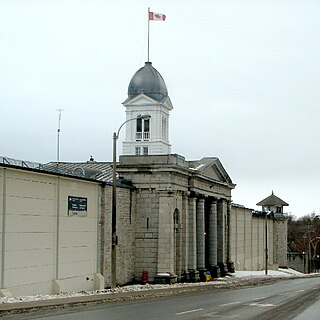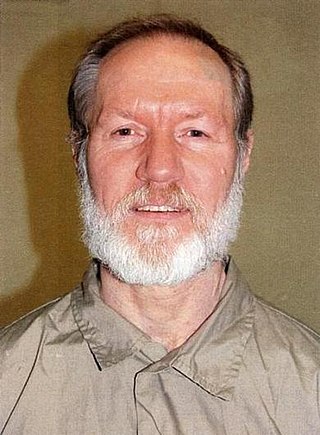Related Research Articles

Kingston Penitentiary is a former maximum security prison located in Kingston, Ontario, Canada, between King Street West and Lake Ontario.

The New Mexico State Penitentiary riot, which took place on February 2 and 3, 1980, at the Penitentiary of New Mexico (PNM) south of Santa Fe, was the most violent prison riot in U.S. history. Inmates took complete control of the prison and twelve officers were taken hostage. Several inmates were killed by other prisoners, with some being tortured and mutilated because they had previously acted as informants for prison authorities. Police regained control of PNM 36 hours after the riots had begun. By then, thirty-three inmates had died and more than two hundred were treated for injuries. None of the twelve officers taken hostage were killed, but seven suffered serious injuries caused by beatings and rapes.
Clayton Charles Ruby was a Canadian lawyer and activist, specializing in constitutional and criminal law and civil rights.
Roger "Mad Dog" Caron was a Canadian robber and the author of the influential prison memoir Go-Boy! Memories of a Life Behind Bars (1978). At the time of publishing, Caron was 39 years old and had spent 23 years in prison.
Jean-Pierre Goyer, was a lawyer and Canadian Cabinet minister.
Millhaven Institution is a maximum security prison located in Bath, Ontario. Approximately 500 inmates are incarcerated at Millhaven.

Oregon State Penitentiary (OSP), also known as Oregon State Prison, is a maximum security prison in the northwest United States in Salem, Oregon. Originally opened in Portland 173 years ago in 1851, it relocated to Salem fifteen years later. The 2,242-capacity prison is the oldest in the state; the all-male facility is operated by the Oregon Department of Corrections (ODOC). OSP contains an intensive management wing, which is being transformed into a psychiatric facility for mentally ill prisoners throughout Oregon.

Thomas Edward Silverstein was an American criminal who spent the last 42 years of his life in prison after being convicted of four separate murders while imprisoned for armed robbery, one of which was overturned. Silverstein spent the last 36 years of his life in solitary confinement for killing corrections officer Merle Clutts at the Marion Penitentiary in Illinois. Prison authorities described him as a brutal killer and a former leader of the Aryan Brotherhood prison gang. Silverstein maintained that the dehumanizing conditions inside the prison system contributed to the three murders he committed. He was the longest-held prisoner in solitary confinement within the Bureau of Prisons at the time of his death. Correctional officers refused to talk to Silverstein out of respect for Clutts.

Menard Correctional Center, known prior to 1970 as Southern Illinois Penitentiary, is an Illinois state prison located in the town of Chester in Randolph County, Illinois. It houses maximum-security and high-medium-security adult males. The average daily population as of 2007 was 3,410.

The Oklahoma State Penitentiary, nicknamed "Big Mac", is a prison of the Oklahoma Department of Corrections located in McAlester, Oklahoma, on 1,556 acres (6.30 km2). Opened in 1908 with 50 inmates in makeshift facilities, today the prison holds more than 750 male offenders, the vast majority of which are maximum-security inmates. They also hold many death row prisoners.
Stephen Henry Champ was a veteran Canadian broadcast journalist, working for CTV News, NBC News and CBC News.
Mountain Institution is a medium security federal penitentiary operated by the Correctional Service of Canada (CSC). It is located in the town of Agassiz, District of Kent, British Columbia, approximately 115 kilometres east of Vancouver, British Columbia.
William James Orton Henderson MBE was a Liberal party member of the House of Commons of Canada. He was born in Empress, Alberta and became a soldier, barrister, lawyer and Supreme Court of Ontario judge.
The British Columbia Penitentiary was a federal maximum security prison located in New Westminster, British Columbia, Canada. The BC Penitentiary operated for 102 years, from 1878 until it was decommissioned in 1980. It was the first federal penal institution west of Manitoba. The Gatehouse was sold on September 8, 2021.

Collins Bay Institution is a multilevel correctional facility in Kingston, Ontario, Canada, and falls under the supervision of Correctional Services of Canada. The facility was opened in 1930, and is now the oldest operational federal penitentiary in Ontario. The main prison is medium security, with a minimum security facility residing on the same property. A 96-bed maximum security unit is also operational.
Brian Leslie Beaucage, better known as "Bo" Beaucage, was a Canadian gangster, outlaw biker and convicted criminal best known as one of the leaders of the 1971 Kingston Penitentiary riot. His plea bargain with the Crown in 1971 is one of the most controversial plea bargains in Canadian legal history.
The Kingston Penitentiary riot of 1971 refers to a prison riot that took place at Kingston Penitentiary, in Ontario, Canada, between 14 and 18 April 1971.
Barrie McKenzie was a Canadian criminal who was credited with a key role in ending the 1971 Kingston Penitentiary riot.
William James "Billy" Knight was a Canadian criminal who served as the leader of the 1971 Kingston Penitentiary riot.
Ronald Bancroft Haggart was a Canadian journalist.
References
- 1 2 3 4 5 6 7 8 9 10 11 12 13 14 15 16 17 18 19 20 21 22 23 24 25 26 27 28 29 Hunter, Paul (4 May 2013). "Life After Life". The Toronto Star. Retrieved 2 September 2023.
- 1 2 3 4 5 6 Goldberg, Susan (4 November 2022). "Teen Wayne Ford was convicted for his mom's 1963 murder". Toronto.com. Retrieved 2 September 2023.
- ↑ Fogarty 2021, p. 91.
- 1 2 Fogarty 2021, p. 56.
- 1 2 Fogarty 2021, p. 57.
- ↑ Fogarty 2021, p. 138-139.
- 1 2 Fogarty 2021, p. 138.
- ↑ Fogarty 2021, p. 291-292.
- ↑ Fogarty 2021, p. 292.